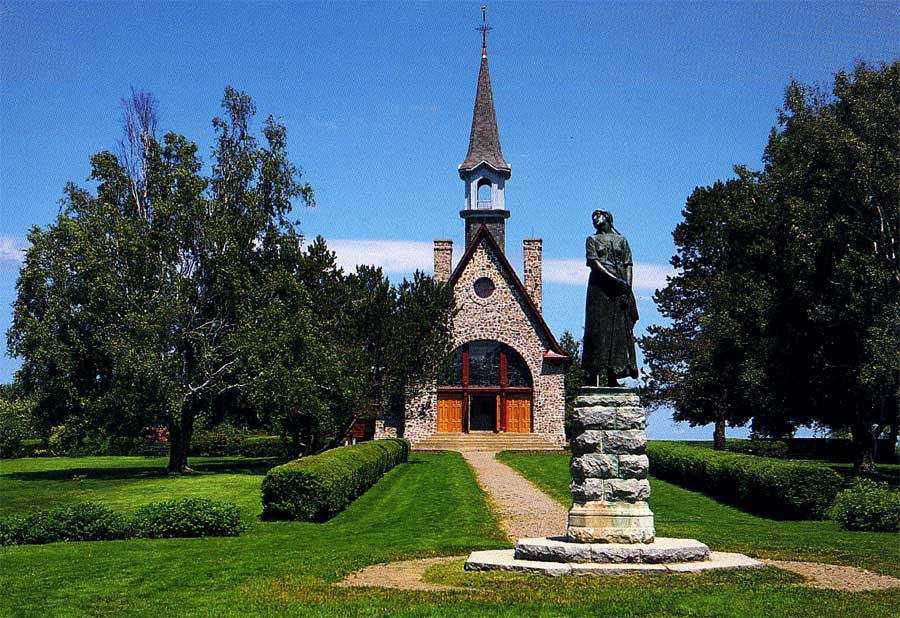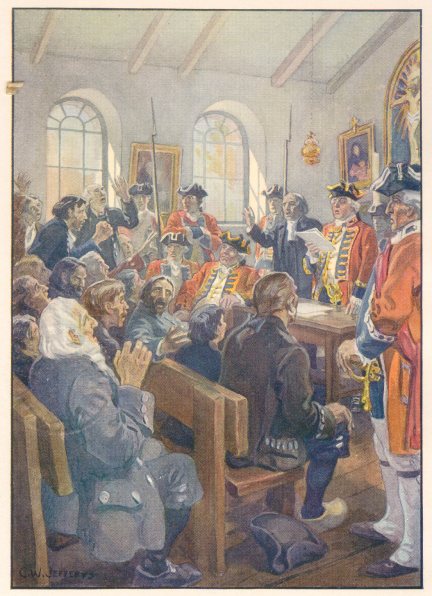History of Grand-Pré:
Acadiens leave Port Royal and settle the Minas Basin area and found St. Charles aux Mines, Grand-Pré, Nova Scotia
Contents
1) Grand-Pré's Historical Significance
2) The Founding of Grand-Pré
3) Grand-Pré Villages
4) Caught Between the Conflicts of Two Colonial Empires - France and Britain
5) The Scene at Grand-Pré during Le Grand Dérangement
6) Winslow's List of Grand-Pré Prisoners
Grand-Pré's Historical Significance
Grand-Pré - Evangeline Statue and Church

Click here for a full size image |
An agreement in 1956 between the Canadian federal government and the Société Nationale l'Assomption, acting on behalf of the Acadian people, acknowledged that: "the Grand-Pré Park is considered the most important historic Site by the Acadian people, that it recalls their saddest and most heroic moments and must remain for future generations the example of courageous people whose culture and actions shall enrich more and more the Canadian nation". The Government of Canada acquired Grand-Pré Memorial Park in 1957 and declared it a national historic site in 1961. The original village of Grand-Pré extended four kilometres along the ridge between present-day Wolfville and Hortonville. Together with the adjacent marshland, this area was designated a Rural Historic District by the Government of Canada in 1995.  Société Promotion Grand-Pré Société Promotion Grand-Pré
 Parks Canada Parks Canada
|
|
|
View Larger Map |
||
The Founding of Grand-Pré
From Information found in:
The history of Grand-Pré: (3d ed.) the home of Longfellow's "Evangeline"; John Frederic Herbin
Grand-Pré (French for great meadow) is located on the shore of the Minas Basin, an area of tidal marshland, first settled about 1680 by Pierre Melanson dit La Verdure, his wife Marguerite Mius d'Entremont and their five young children who came from nearby Port-Royal which was the first capital of the French settlement of Acadia (Acadie in French).
Grand-Pré National Historic Site is a park set aside to commemorate the Grand-Pré area of Nova Scotia as a center of Acadian settlement from 1682 to 1755, and the deportation of the Acadians which began in 1755 and continued to 1762. The original village of Grand Pré extended four kilometres along the ridge between present-day Wolfville and Hortonville. Together with the adjacent marshland, this area was designated a Rural Historic District by the Government of Canada in 1995
In 1686, Minas had approxiamately 57 individuals, 10 families, 83 acres tilled, 90 horned cattle, 21 sheep, 67 swine, 20 guns. Among the settlers was Pierre Melanson, called La Verdure, aged 54, born in 1632, and Marie Muis D'Antremon, his second wife, aged 36, born in 1650. Their nine children were from one to twenty years old. Pierre Melanson came from Port Royal and was the brother of Charles Melanson dit La Ramee, founder of The Melanson Settlement
. His name was affixed to the marriage settlement of La Tour and Madame D'Aulney in 1653. In 1654 Melanson was the tutor to the children of the then dead D'Aulney, proprietor of the country.
Pierre Melanson dit LaVerdure was chief man at Minas to transmit all orders from the governors, and to have them executed.
Pierre Melanson and the Acadians who joined him in Grand-Pré built dykes there to hold back the tides along the Minas Basin. They created rich pastures for their animals and fertile fields for their crops. Grand-Pré became the bread basket of Acadia, soon outgrew Port-Royal, and by the mid-18th century was the largest of the numerous Acadian communities around the Bay of Fundy and the coastline of Nova Scotia (Latin for "New Scotland"). The dyke building required united effort and great skill, especially in putting down a sluice in the bed of the river channel, to let out the fresh water from within, and to keep out the salt water of the rapid tides.
The first account we have of a dyke and sluice is in " Voyage du Sieur de Dierville en Acadie, ou Nouvelle France," in the year 1699, published in 1708. The reference is as follows:
" It is necessary, in order to raise grains, to drain the marshes, which the sea at high tide overflows with its waters; and which they (the Acadians) call the lowlands. Those lands are good enough; but what labor does it require to put them in condition for cultivation ? It is not easy to stay the course of the sea; the Acadians, nevertheless, accomplish the task by means of strong dykes, which they call aboteaux; and this is how they make them: They set up five or six rows of large trees, quite entire, at the places by which the sea enters the marshes, and between the rows they lay other trees lengthwise, one upon another, and they fill all the empty spaces so well with soft clay, well packed, that the water can no longer pass through. They fit in the middle of these works a flood-gate (un esseau) in such a manner that it allows, at low tide, the marsh-water to flow out by its own pressure, and prevents the water of the sea from entering."
The District of Minas included the parish of St. Joseph at Canard River, and that of St. Charles at Grand-Pre. The churches were of wood, with towers from which, twice a day, came the sound of L'Angelus. We have an interesting account of a visit to Grand-Pre, or Minas, as it was called, in 1686, by Bishop Valliers, of Quebec. We learn from him that the inhabitants were young men, well built, and hard working. They had left Port Royal to settle there. They were draining the marshes and building dykes.
They were without spiritual guidance, and the Bishop stopped a day to minister to them, giving them instruction, hearing confession and giving communion in the morning; and in the afternoon he baptized some children, and settled some differences between them. They had been without religious instruction for some time, and they pleaded for a priest to be given them, promising not only to support him, but to build a church and a parochial house. Where now stand the French willows and the old well so much visited every year, was then known as an island, being surrounded by water at high tides. This strip of land was offered by the owner as a site for the church and house, either the whole or a part of it. Here, eventually, the church and priest's house were built. The burying ground was also near by. The location of these may be seen to-day. This spot was in 1755 used by Colonel Winslow for himself and his regiment when the Acadians were being deported.
Grand-Pré Villages
The principal villages on the south side of Minas River, now the Cornwallis, sometimes called Minas or Grand-Pre, were Gotro, Pierre Le Blanc, Michel, Melanson, Grand Le Blanc, Gaspereau, Jean Le Blanc and Grand-Pre. On the north side of the same river, the villages of the Canard section, sometimes called Habitant arid Canard, because the settlements were mainly on the Habitant and Canard rivers, were named : Claude Landry, Antoine, Hebert, Dupuis,Brun,Trahan, Saulnier, Poirier and Hebert. The remaining villages had less than twenty inhabitants.
At Grand-Pre and Gaspereau, and along the south side of Minas, the common names of the Acadians in the order of their frequency were : Le Blanc, Melanson, Hebert, Richard. On the north side the common names were: Boudro, Comeau, Landry, Aucoine, Granger, Terriau, Dupuis.
Grand-Pré (2nd Edition); A Sketch of the Acadian Occupation of the Shores of the Basin of Minas; The Home of Longfellow's Evangeline; John Frederic Herbein
British Decide to Deport the Acadians - Story at Grand-Pré
The first recorded attempt at ethic cleansing in North America
It was evidently the desire of Lawrence that the Acadians should not take the oath. He acted promptly. Everything was ripe for the undertaking. It was decided on July 28, 1755, to deport the Acadians. New England troops were in the country, having assisted in the capture of Beausejour. In a letter to the commandant, Moncton, he informed him that the French of that place were to be removed at once, as soon as transports, which had been ordered, should come up the Bay. Very full particulars were given as to the removal of the people and the seizure of property and cattle. Not the slightest trace of pity or compunction is apparent in the orders he issued to the officers in command at the different centres. If the people had been animals or wild beasts, and likely to escape in spite of his vigilance, he could not have been more merciless in working out the soulless scheme of the deportation.
British forces take the Acadien population into custody
Le Grand Dérangement Commences at Grand-Pré
September 5, 1755 - Acadien Inhabitants of Grand-Pré are detained
as prisoners of the British Crown
On September 5, 1755, at Grand-Pré, Kings County, N.S., over 400 unarmed Acadien men and youths were assembled and marched into the local church. There the commander of the British Provincial Troops, Lieutenant Colonel John Winslow, under order of Governor Charles Lawrence informed the Acadiens they had been called together to hear the decision of the King of England in regard to the French inhabitants of the province:
 painting by C.W. Jefferys |
"your lands and tenements, cattle of all kinds, and live-stock of all sorts, are forfeited to the crown, and you, yourselves, are to be removed from this province. I am, through his Majesty's goodness, directed to allow you liberty to carry off your money and household goods, as many as you can, without discommoding the vessels you go in. Thus it is peremptorily his Majesty's orders that the whole French inhabitants of these Districts be removed; and hope that, in whatever part of the world you may fall, you may be faithful subjects, a peaceable and happy people." |
|
At conclude of his announcement, Colonel Winslow declared that the adult male poulation of the Acadien communities of Grand-Pré and the Minas Basin were to be held as prisoners of the British Crown:
"I must also inform you, that it is his Majesty's pleasure that you remain in security under the inspection and direction of the troops that I have the honor to command".
" After carrying off the priests, the English raised their flag above the churches and made the latter into barracks when their troops passed there. . . . The missionaries reached Halifax with this fine accompaniment, drums beating. They were led out on the parade, where they were exposed for three-quarters of an hour to mockery, contempt and Insults."
Lieutenant Colonel John Winslow, the commanding officer that was charged with the forcible removal of young Acadian men at Grand-Pré, later that month, described the scene in a letter dated September 10, 1755:
"Order ye Prisoners to March. They all answered they would not go without their fathers. I told them that was a word I did not understand for that the King's Command was to be absolute and should be absolutely obeyed, and that I did not love to use harsh means, but that the time did not admit of parleys or delays, and then ordered the whole troops to fix their bayonets and advance towards the French. I bid the four right-hand files of the prisoners, consisting of twenty-four men, which I told off myself to divide from the rest, one of whom I took hold on (who opposed the marching) and bid march. He obeyed and the rest followed, though slowly, and went off praying, singing, and crying, being met by the women and children all the way."
Note: This page is currently under construction |
Links for more information on Grand-Pré: |
||
|
Northeast Archaeological Research - Grand-Pré National Historic Site - Grand-Pré, Nova Scotia |
||
Page Sources:
Journal of John Winslow of the Provincial Troops While Engaged in Removing the Acadian French Inhabitants from Grand-Pré, and the Neighbouring Settlements, In the Autumn of the Year 1755; From: Report and Collections of the Nova Scotia Historic Society for the Years 1882-1883, Vol. 3; Halifax, N.S., Printed at the Morning Herald Office, 1883 : p71-196; Transcribed from the original manuscript journal, in the library of the Historical Society of Massachusetts, by permission of the Society, in March 1880, under the direction of the record commission.
Online transcription available at Nova Scotia Historical Society III - Journal of Colonel John Winslow .
The history of Grand-Pré: (3d ed.) the home of Longfellow's "Evangeline"; John Frederic Herbin
Société Promotion Grand-Pré Web Site
 Société Promotion Grand-Pré
Société Promotion Grand-Pré
Parks Canada Web Site
 Parks Canada
Parks Canada
 yahoo.com
yahoo.com